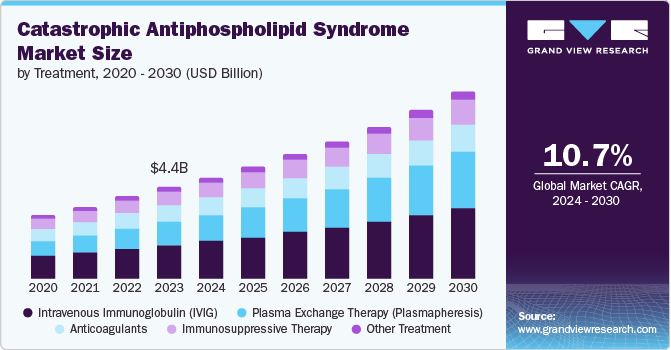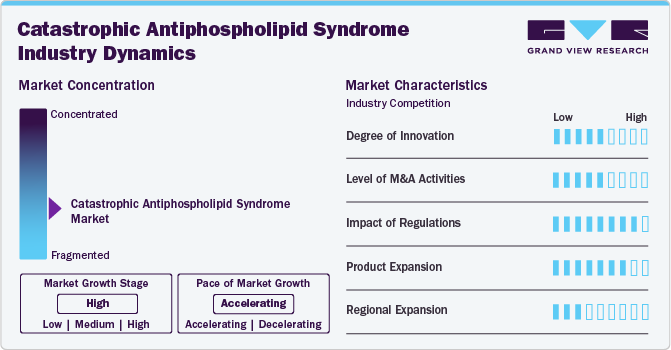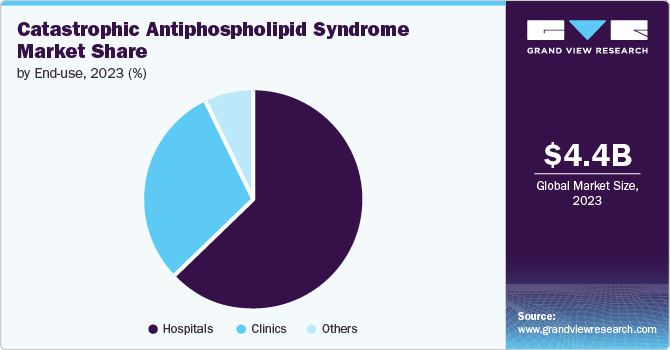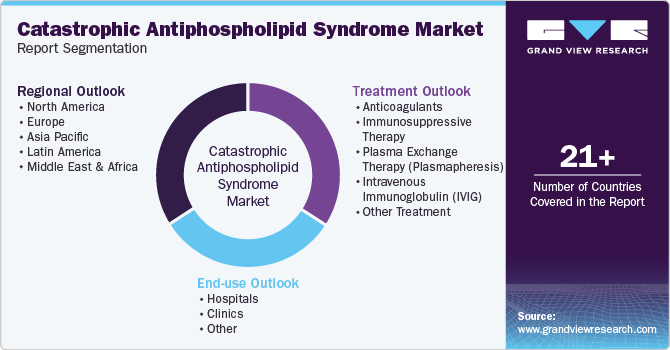- Home
- »
- Pharmaceuticals
- »
-
Catastrophic Antiphospholipid Syndrome Market Report 2030GVR Report cover
![Catastrophic Antiphospholipid Syndrome Market Size, Share & Trends Report]()
Catastrophic Antiphospholipid Syndrome Market Size, Share & Trends Analysis Report By Treatment (Anticoagulants, Immunosuppressive Therapy, Plasma Exchange Therapy), By End-use (Hospitals, Clinics), By Region, And Segment Forecasts, 2024 - 2030
- Report ID: GVR-4-68040-425-0
- Number of Report Pages: 100
- Format: PDF, Horizon Databook
- Historical Range: 2018 - 2022
- Forecast Period: 2024 - 2030
- Industry: Healthcare
Market Size & Trends
The global catastrophic antiphospholipid syndrome market size was estimated at USD 4.41 billion in 2023 and is projected to grow at a CAGR of 10.7% from 2024 to 2030. The market is driven by several key factors, including the increasing prevalence of autoimmune diseases, advancements in diagnostic technologies, growing awareness and education regarding CAPS, and the development of novel therapeutic options. According to the National Health Council, Autoimmune diseases affect approximately 50 million Americans, but the actual number is likely much higher due to underdiagnosis. Alarmingly, autoimmunity is rising at an epidemic rate, with estimates of a 3-12% annual increase.

One significant driver is the increasing prevalence of autoimmune diseases, which are linked to environmental, genetic, and lifestyle factors. The rising incidence of these underlying conditions contributes to more CAPS cases, expanding the patient population requiring specialized treatment. This surge in autoimmune disorders correlates with the incidence of catastrophic antiphospholipid syndrome (CAPS), as it occurs in patients with existing autoimmune conditions such as systemic lupus erythematosus. The association between autoimmune diseases and CAPS underscores the need for targeted therapies and increased healthcare resources to manage these complex conditions effectively.
Advancements in diagnostic technologies also play a crucial role in driving the market growth. Improved laboratory tests, including detecting antiphospholipid antibodies, enhanced the ability to diagnose catastrophic antiphospholipid syndrome more accurately and promptly. Early diagnosis significantly improves patient outcomes, with timely interventions reducing the risk of severe complications. The development of new diagnostic algorithms and criteria further aids healthcare providers in identifying CAPS cases, thereby increasing the number of diagnosed patients and the demand for treatment options.
Market Concentration & Characteristics
Degree of innovation in the global market is considered medium. Advancements focused on improving diagnostic methods and treatment options. Innovative therapies such as monoclonal antibodies and anticoagulants are undergoing clinical trials to provide more effective management strategies for this rare condition. Developing more precise diagnostic tools, such as advanced imaging techniques and biomarker assays, is enhancing early detection and personalized treatment strategies. This focus on innovation is essential for addressing the complexities of CAPS and improving overall patient care.
Level of merger and acquisition (M&A) activities in the market is considered medium. This assessment is based on several factors, including the increasing recognition of CAPS as a significant clinical condition that requires targeted therapies. It attracted interest from pharmaceutical companies looking to expand their portfolios in rare diseases. The market saw some strategic partnerships and acquisitions to enhance research capabilities and accelerate drug development processes.

Impact of regulations on the market is high, as regulatory bodies, including the FDA, impose stringent guidelines for drug approval and safety monitoring. The approval process for novel therapies can be lengthy and complex, which may delay the availability of potentially beneficial treatments for catastrophic antiphospholipid syndrome patients. However, recent initiatives by regulatory agencies to expedite the approval of treatments for rare diseases have positively influenced the market.
Product expansion in the market is high, with pharmaceutical companies actively pursuing developing new treatment options and therapies. There is a growing pipeline of investigational drugs to treat catastrophic antiphospholipid syndrome (CAPS), including various anticoagulants and immunotherapies. For example, the introduction of combination therapies that integrate traditional anticoagulation with novel agents is gaining traction, as these approaches may enhance treatment efficacy and reduce complications. This proactive stance on product expansion reflects the urgent need to address the unmet medical needs of CAPS patients and improve their quality of life.
Region expansion in the global market is low, primarily due to its classification as a rare disease with limited patient populations globally. However, there is a growing interest in emerging markets where awareness about autoimmune diseases is increasing. Companies are beginning to explore opportunities in Asia-Pacific and Latin America, aiming to educate healthcare providers about CAPS and expand access to treatment options.
Treatment Insights
Based on treatment, the intravenous immunoglobulin (IVIG) segment led the market with the largest revenue share of 36.93% in 2023, due to its immunomodulatory properties that help mitigate the severe manifestations of this condition. IVIG provides a broad spectrum of antibodies that can neutralize these harmful antibodies and modulate the immune response, reducing inflammation and preventing further clotting events. The increasing prevalence of autoimmune disorders, coupled with rising awareness among healthcare professionals regarding the efficacy of IVIG in treating catastrophic antiphospholipid syndrome, drove its market growth.
The plasma exchange therapy (plasmapheresis) segment is expected to grow at the fastest CAGR of 13.6% during the forecast period, due to its critical role in managing severe disease cases. Plasma exchange effectively removes pathogenic factors from the plasma, such as autoantibodies and pro-inflammatory cytokines, which are implicated in exacerbating CAPS symptoms. The increasing recognition of the benefits of plasma exchange, combined with a growing body of clinical evidence supporting its efficacy, is driving its adoption in clinical practice. In addition, advancements in plasma exchange technology and protocols make the procedure more accessible and effective, further contributing to market growth.
End-use Insights
Based on end use, the hospital segment led the market with the largest revenue share of 62.80% in 2023. Hospitals are the primary healthcare settings where CAPS patients receive comprehensive care, including diagnosis, treatment, and management of the condition. Catastrophic antiphospholipid syndrome (CAPS) is a medical emergency that requires immediate hospitalization and intensive care, driving the demand for hospital services. As hospitals continue to invest in advanced diagnostic technologies, such as thrombophilia testing and imaging modalities, and offer a wide range of treatment options, including anticoagulation therapy, immunosuppressants, and supportive care, their revenue share in the CAPS market is expected to remain significant in the coming years.

The clinics segment is expected to grow at the fastest CAGR during the forecast period.These clinics are increasingly recognized for their focused expertise and tailored treatment plans, which are essential for managing complex conditions, including catastrophic antiphospholipid syndrome that involve recurrent thrombosis and pregnancy complications. The rise in awareness about CAPS among healthcare professionals and patients led to a surge in referrals to these specialized facilities, where multidisciplinary teams can provide comprehensive care. In addition, advancements in diagnostic technologies and treatment protocols specific to antiphospholipid syndrome enhanced patient outcomes, further driving demand for clinics.
Regional Insights
North America dominated the catastrophic antiphospholipid syndrome market with the largest revenue share of 39.54% in 2023, as it is characterized by a strong focus on innovation and the introduction of novel therapies. The increasing prevalence of lung cancer, particularly adenocarcinoma, has prompted healthcare providers to adopt more tailored treatment approaches that consider the genetic makeup of tumors. Introducing novel therapies such as immune checkpoint inhibitors and targeted agents such as EGFR inhibitors has revolutionized treatment protocols. In addition, the market is witnessing increased mergers and acquisitions among pharmaceutical companies to expand their product portfolios and enhance research capabilities.

U.S. Catastrophic Antiphospholipid Syndrome Market Trends
The catastrophic antiphospholipid syndrome market in the U.S. is characterized by rapid innovation and a competitive landscape marked by strategic mergers and acquisitions among pharmaceutical companies. The approvals of new drugs expanded treatment options significantly; for instance, the FDA’s accelerated approval pathways have facilitated quicker access to promising therapies for patients with advanced disease stages. For instance, in March 2022, the FDA approved Opdivo (nivolumab) in combination with chemotherapy as a neoadjuvant treatment for certain adult patients with resectable non-small cell lung cancer (NSCLC).
Europe Catastrophic Antiphospholipid Syndrome Market Trends
The catastrophic antiphospholipid syndrome market in Europe is characterized by a growing awareness of the disease and its severe implications. Diagnostic technique innovations improved CAPS identification, leading to earlier intervention and better patient outcomes. The European Medicines Agency (EMA) is actively evaluating new treatment options, including monoclonal antibodies targeting specific pathways involved in thrombosis associated with antiphospholipid syndrome. According to estimates from the National Centre for Biotechnology Information (NCBI), the incidence of catastrophic antiphospholipid syndrome (APS) in Europe is approximately 1.1 cases per 100,000 individuals.
The UK catastrophic antiphospholipid syndrome market is influenced by significant advancements in personalized medicine and tailored treatment approaches. The National Health Service (NHS) initiated programs focusing on improving care for patients with rare diseases, including CAPS. This resulted in increased funding for research into effective treatments and management strategies. Notably, recent clinical trials showed promising results for new anticoagulant therapies that could potentially reduce CAPS-related morbidity. Furthermore, there are ongoing discussions regarding potential mergers between pharmaceutical companies specializing in rare autoimmune disorders, which could enhance research capabilities and expedite the development of innovative treatments for CAPS.
The catastrophic antiphospholipid syndrome market in France is anticipated to grow at the fastest CAGR during the forecast period. A growing focus on patient-centric care and a strong emphasis on research and development within the pharmaceutical sector characterize the market growth in France. The French government supports research initiatives to develop new treatment modalities, including advanced anticoagulants and immunotherapies specifically for CAPS. This commitment to innovation and improved patient management is expected to drive market growth in France, enhancing the overall treatment landscape for affected individuals.
Asia Pacific Catastrophic Antiphospholipid Syndrome Market Trends
The catastrophic antiphospholipid syndrome market in the Asia Pacific region is witnessing a growing awareness, which is leading to increased diagnosis rates. This rise can be attributed to the introduction of advanced diagnostic techniques. Innovative treatment options are being developed, including monoclonal antibodies and targeted therapies that aim to reduce CAPS-associated thrombotic events. In addition, the increasing prevalence of autoimmune diseases in this region drives market growth as healthcare providers seek effective management strategies for patients suffering from CAPS.
The Japan catastrophic antiphospholipid syndrome market is characterized by a strong emphasis on research and development (R&D). Japanese pharmaceutical companies actively engage in clinical trials to explore new therapeutic agents specifically targeting CAPS. The country saw recent launches of novel anticoagulants that have shown promise in managing thrombotic complications associated with the syndrome. Furthermore, Japan's regulatory framework supports expedited approval processes for innovative treatments, encouraging faster patient access to new therapies. The integration of precision medicine into treatment protocols is also gaining traction, allowing for more personalized approaches to managing catastrophic antiphospholipid syndrome.
The catastrophic antiphospholipid syndrome market in China is rapidly evolving due to significant investments in the biotechnology sector. The government implemented policies to improve patient access to advanced treatments and enhance disease awareness among healthcare professionals. In addition, there is a growing trend towards integrating traditional Chinese medicine with conventional therapies, offering patients a broader range of therapeutic options. The rising incidence of autoimmune disorders in China further underscores the need for effective management solutions tailored to CAPS.
Latin America Catastrophic Antiphospholipid Syndrome Market Trends
The catastrophic antiphospholipid syndrome market in Latin America is experiencing a notable increase in awareness and diagnosis of the condition, which is crucial given its rarity and severity. Recent initiatives by healthcare organizations aim to educate medical professionals and patients about catastrophic antiphospholipid syndrome, leading to improved detection rates. In addition, there was a rise in research collaborations focusing on the development of innovative treatment options, including new anticoagulants and immunotherapies tailored for CAPS patients. Ongoing clinical trials are exploring the efficacy of novel therapies, which may provide better management strategies for CAPS and improve patient outcomes in the region.
The Brazil catastrophic antiphospholipid syndrome market is characterized by increasing prevalence rates and significant investment in healthcare infrastructure to improve patient outcomes. The Brazilian government actively promotes research into rare diseases such as catastrophic antiphospholipid syndrome through funding programs and partnerships with academic institutions. For instance, in September 2023, the Brazilian government initiated the CEIS Development Strategy to strengthen the nation's capacity to produce vital supplies for its Unified Health System (SUS).
Middle East & Africa Catastrophic Antiphospholipid Syndrome Market Trends
The catastrophic antiphospholipid syndrome market in the Middle East and Africa is characterized by a growing awareness of autoimmune diseases, leading to increased diagnosis and treatment rates. Unique factors influencing this market include the rising prevalence of systemic lupus erythematosus (SLE) and other autoimmune disorders, which are often associated with CAPS. Innovative treatment options, such as monoclonal antibodies and anticoagulants, are being developed to address the complexities of CAPS.
The Saudi Arabia catastrophic antiphospholipid syndrome market is experiencing growth driven by increased government initiatives to improve healthcare infrastructure and patient care. According to the International Trade Administration, in 2023, Saudi Arabia allocated $50.4 billion for healthcare, representing 16.96% of its budget, emphasizing the sector's priority. The government aims to privatize healthcare services, targeting a 65% contribution from the private sector by 2030, enhancing innovation and treatment options. Furthermore, collaborations between local healthcare providers and international pharmaceutical companies are fostering the development of innovative treatment options, such as advanced anticoagulants and immunotherapies, aimed at improving patient outcomes in CAPS.
Key Catastrophic Antiphospholipid Syndrome Company Insights
The market is characterized by the presence of several major pharmaceutical companies that are actively involved in the development and marketing of therapies for the condition. These companies held a significant market share and continuously invested in research and development to create more effective and targeted treatments. Some key players in the global market are involved in mergers and acquisitions to expand their product portfolios and enhance their market position. The competitive landscape of the market is expected to intensify in the coming years as more companies enter the market and strive to develop innovative therapies to address the unmet medical needs of patients with this rare and life-threatening condition.
Key Catastrophic Antiphospholipid Syndrome Companies:
The following are the leading companies in the catastrophic antiphospholipid syndrome market. These companies collectively hold the largest market share and dictate industry trends.
- Pfizer
- Abbott
- Bristol-Myers Squibb Company
- Eli Lilly and Company
- Boehringer Ingelheim International GmbH
- Novartis AG
- Merck KGaA
- AbbVie Inc.
- F. Hoffmann-La Roche
- Johnson & Johnson Services, Inc.
Recent Developments
- In August 2024, Cadrenal Therapeutics is developing tecarfarin, an oral anticoagulant aimed at treating catastrophic antiphospholipid syndrome (CAPS), which causes severe clotting and multi-organ failure, potentially offering a new management option for this critical condition.
Catastrophic Antiphospholipid Syndrome Market Report Scope
Report Attribute
Details
Market size value in 2024
USD 4.89 billion
Revenue forecast in 2030
USD 8.99 billion
Growth rate
CAGR of 10.7% from 2024 to 2030
Base year for estimation
2023
Historical data
2018 - 2022
Forecast period
2024 - 2030
Quantitative units
Revenue in USD million/billion and CAGR from 2024 to 2030
Report coverage
Revenue forecast, company ranking, competitive landscape, growth factors, and trends
Segments covered
Treatment, end-use, region
Regional scope
North America; Europe; Asia Pacific; Latin America; MEA
Country scope
U.S.; Canada; Mexico; UK; Germany; France; Italy; Spain; Sweden; Denmark; Norway; China; Japan; India; Australia; South Korea; Thailand; Brazil; Argentina; Saudi Arabia; South Africa; UAE; Kuwait
Key companies profiled
Pfizer; Abbott; Bristol-Myers Squibb Company; Eli Lilly and Company; Boehringer Ingelheim International GmbH; Novartis AG; Merck KGaA; AbbVie, Inc.; F. Hoffmann-La Roche; Johnson & Johnson Services, Inc.
Customization scope
Free report customization (equivalent up to 8 analyst’s working days) with purchase. Addition or alteration to country, regional & segment scope
Pricing and purchase options
Avail customized purchase options to meet your exact research needs. Explore purchase options
Global Catastrophic Antiphospholipid Syndrome Market Report Segmentation
This report forecasts revenue growth at global, regional, and country levels and provides an analysis of the latest industry trends in each of the sub-segments from 2018 to 2030. For this study, Grand View Research has segmented the global catastrophic antiphospholipid syndrome treatment market report based on treatment, end-use, and region.

-
Treatment Outlook (Revenue, USD Million, 2018 - 2030)
-
Anticoagulants
-
Immunosuppressive Therapy
-
Plasma Exchange Therapy (Plasmapheresis)
-
Intravenous Immunoglobulin (IVIG)
-
Other Treatment
-
-
End-use Outlook (Revenue, USD Million, 2018 - 2030)
-
Hospitals
-
Clinics
-
Other
-
-
Regional Outlook (Revenue, USD Million, 2018 - 2030)
-
North America
-
U.S.
-
Canada
-
Mexico
-
-
Europe
-
Germany
-
UK
-
France
-
Italy
-
Spain
-
Denmark
-
Sweden
-
Norway
-
-
Asia Pacific
-
China
-
Japan
-
India
-
South Korea
-
Australia
-
Thailand
-
-
Latin America
-
Brazil
-
Argentina
-
-
Middle East and Africa (MEA)
-
South Africa
-
Saudi Arabia
-
UAE
-
Kuwait
-
-
Frequently Asked Questions About This Report
b. The global catastrophic antiphospholipid syndrome market was valued at USD 4.41 billion in 2023 and is expected to reach USD 8.99 billion in 2024.
b. The global catastrophic antiphospholipid syndrome market is expected to grow at a CAGR of 10.7% from 2024 to 2030 to reach USD 8.99 billion by 2030.
b. The intravenous immunoglobulin (IVIG) segment represented the largest revenue share of 36.93% in 2023 due to its immunomodulatory properties that help mitigate the severe manifestations of this condition.
b. Some of the prominent players in the global CAPS market are Pfizer, Abbott, Bristol-Myers Squibb Company, Eli Lilly and Company, Boehringer Ingelheim International GmbH, Novartis AG, Merck KGaA, AbbVie Inc., F. Hoffmann-La Roche and others.
b. The catastrophic antiphospholipid syndrome (CAPS) market is driven by several key factors, including the increasing prevalence of autoimmune diseases, advancements in diagnostic technologies, growing awareness and education regarding CAPS, and the development of novel therapeutic options.
Share this report with your colleague or friend.
![gvr icn]()
NEED A CUSTOM REPORT?
We can customize every report - free of charge - including purchasing stand-alone sections or country-level reports, as well as offer affordable discounts for start-ups & universities. Contact us now
![Certified Icon]()
We are GDPR and CCPA compliant! Your transaction & personal information is safe and secure. For more details, please read our privacy policy.
We are committed towards customer satisfaction, and quality service.
"The quality of research they have done for us has been excellent."





